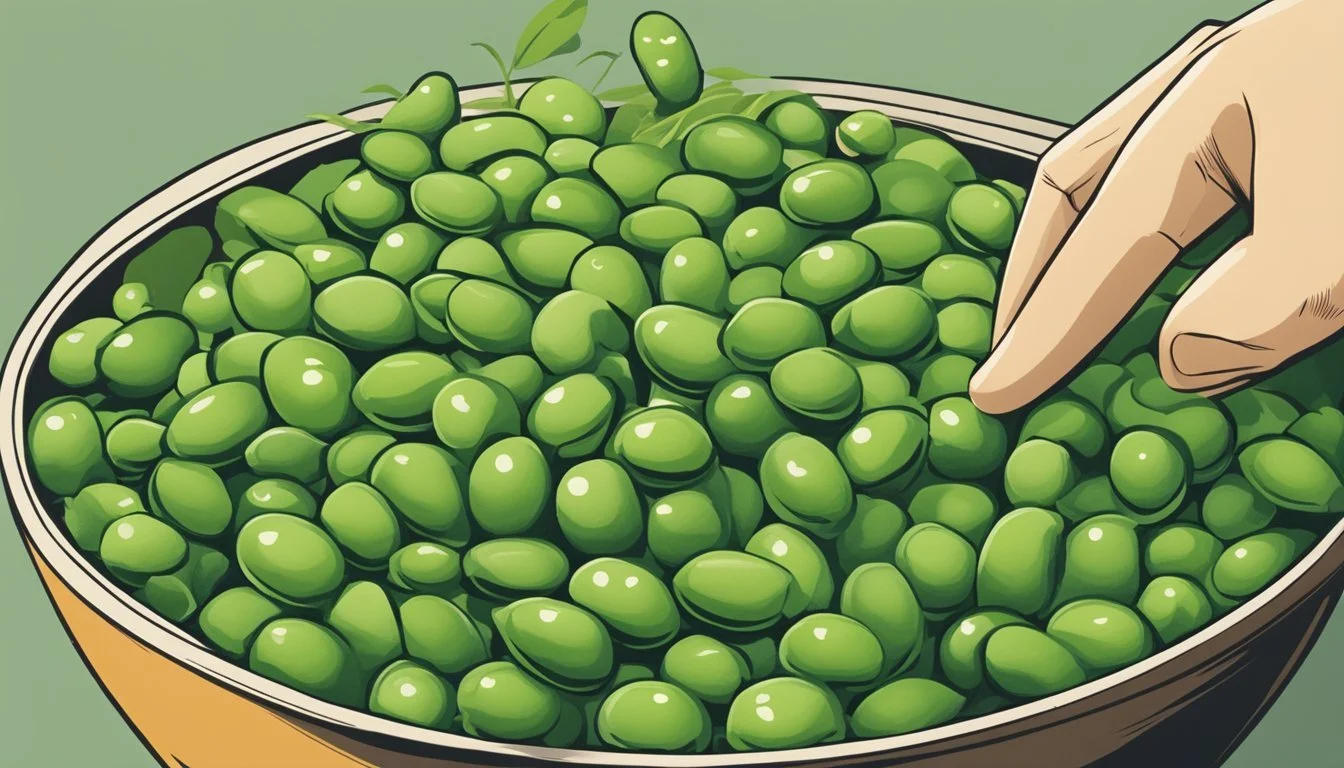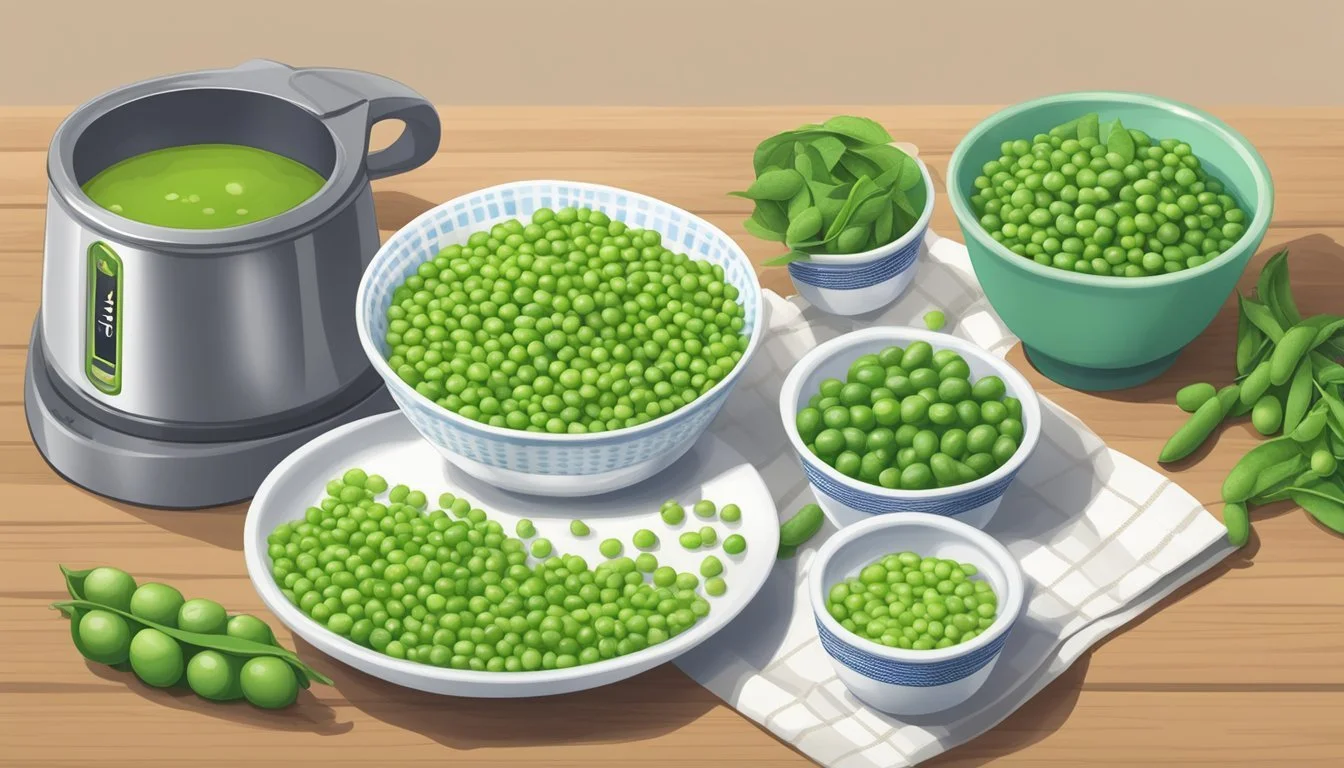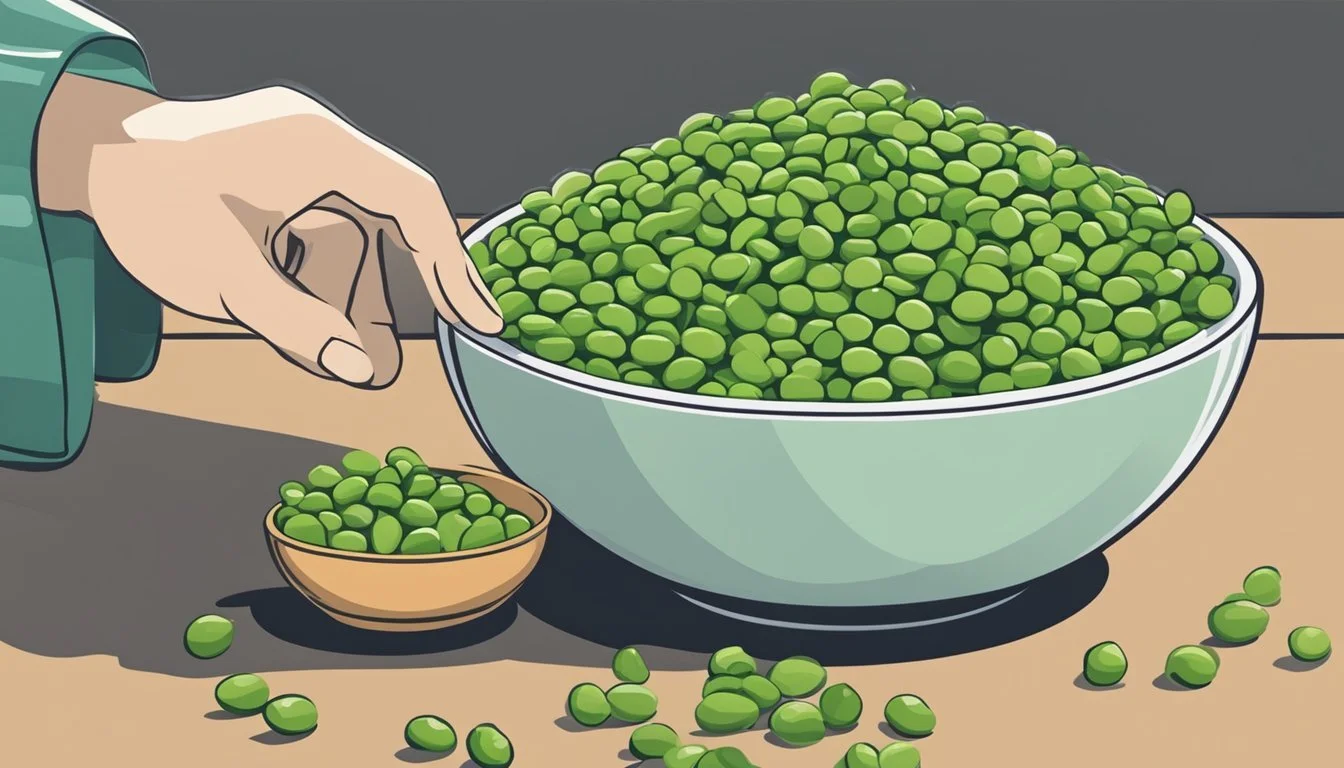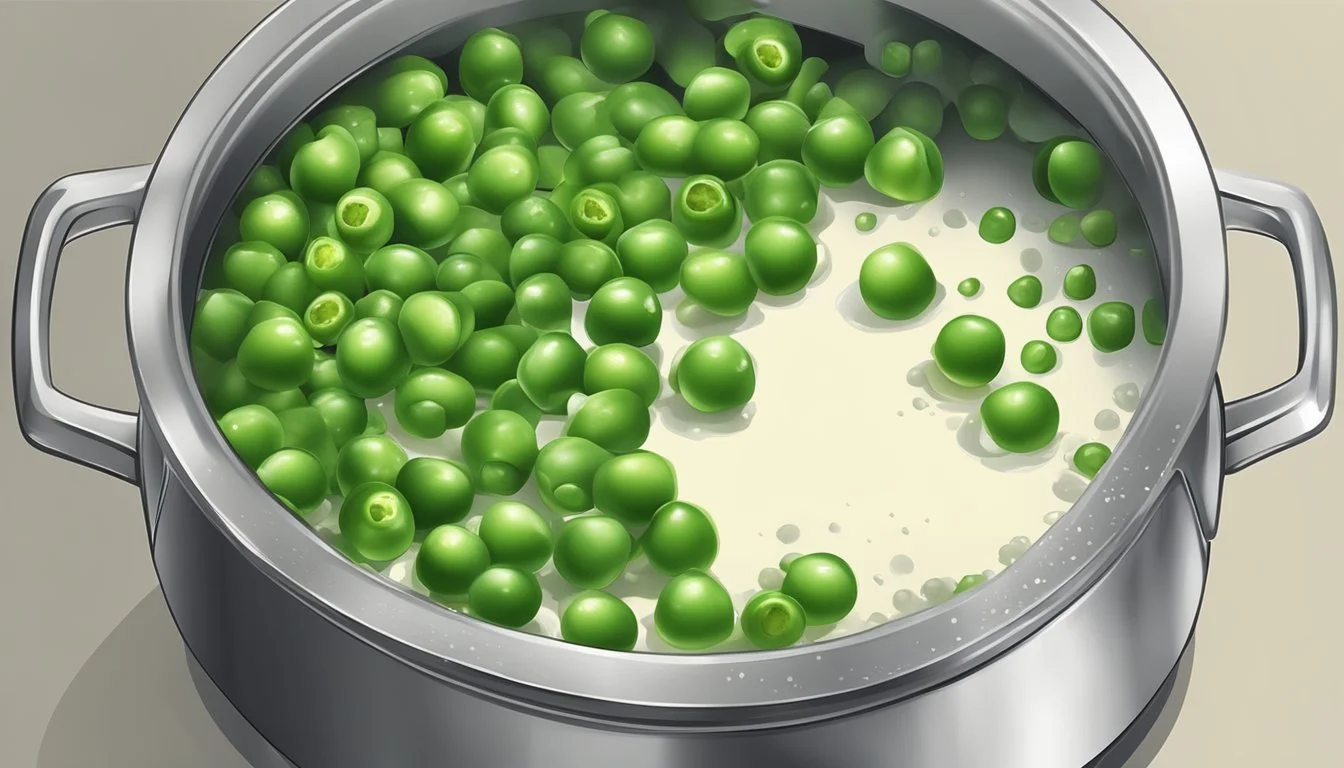How to Substitute Green Peas for Edamame
Simple Swaps for Your Recipes
Edamame, the young soybeans traditionally served steamed and salted, is a staple in many Asian cuisines and has become popular worldwide as a snack and ingredient due to its health benefits and versatility. However, there are instances when a substitute for edamame is required, either due to availability or dietary preferences. Green peas emerge as a fitting alternative to edamame as they are easily accessible and share a number of similar characteristics, including color, taste, and nutritional value.
When substituting green peas for edamame, cooks find that they can achieve a similar earthy flavor and a delightful green hue in their dishes. This swap is particularly handy as green peas can be used in a one-to-one ratio, meaning that a cup of green peas can directly replace a cup of edamame in most recipes. This makes the substitution process straightforward and user-friendly.
It is important for those looking to make the switch to consider the textural differences between these two legumes. While both are satisfyingly tender, green peas tend to be a bit softer, especially when cooked. The required cooking time may also differ slightly, given the respective sizes of edamame and green peas. Chefs might need to adjust the cooking duration to ensure that the peas are tender yet still retain some bite, mirroring the firmness of edamame.
Understanding Edamame
Before diving into the world of edamame substitutions, it's crucial to grasp what edamame is and its nutritional significance.
What Is Edamame
Edamame are young soybeans, often found still encased in their pods. Unlike mature soybeans, which are typically hard and beige, edamame are soft and green. They are harvested before reaching maturity, which is why their texture and taste are markedly different from that of their fully-grown counterparts. Traditionally, edamame beans are boiled or steamed and can be consumed directly from the pod, often seasoned with salt or other spices.
Nutritional Profile of Edamame
The nutritional value of edamame is noteworthy. One cup of cooked edamame provides approximately 31 grams of protein, making it a plant-based powerhouse for those seeking to incorporate more protein into their diets. Moreover, edamame are a rich source of fiber, aiding in healthy digestion.
Key vitamins found in edamame include:
Vitamin K: Essential for blood clotting and bone health.
Vitamin C: Important for the immune system and skin health.
In terms of minerals, edamame offers a great source of:
Calcium: Vital for bone health and muscle function.
Iron: Necessary for the transportation of oxygen in the blood.
Edamame is also packed with antioxidants, which help protect the body from oxidative stress, and a variety of other important nutrients that contribute to overall health.
Green Peas as a Substitute
When looking to replace edamame in a recipe, green peas offer a valuable alternative due to their nutritional alignment and similar taste and texture profile. They are an excellent choice for those looking to maintain the character of their dishes while making use of readily available ingredients.
Nutritional Similarities to Edamame
Green peas carry a comparable nutritional footprint to edamame, which makes them a suitable substitute in meals. Both are excellent sources of fiber and protein, contributing to a healthy diet. The most notable common nutritional aspects include:
Fiber Content: Green peas contain significant amounts of dietary fiber, which is crucial for digestive health and highly similar to the fiber content found in edamame.
Protein Levels: They are also rich in protein, essential for the body's repair and growth, although green peas typically have slightly less protein per serving compared to edamame.
Taste and Texture Comparison
The taste and texture of green peas are closely aligned with those of edamame, ensuring that dishes will retain their intended flavor and mouthfeel when this substitution is made. Key points include:
Taste: Green peas have a mildly sweet flavor, resonating with the slightly nutty and sweet taste of edamame beans.
Texture: They provide a soft yet slightly firm texture upon cooking, which can mirror the satisfying bite that edamame is known for in various dishes.
Exploring Other Substitutes for Edamame
When one seeks to replace edamame in a recipe, considering taste, texture, and nutritional content is crucial. Both the bean and legume family, as well as various green vegetables, offer viable alternatives.
Beans and Legumes
The family of beans and legumes houses several substitutes that can mimic edamame's consistency and provide a similar nutritional profile. For a close match in flavor and texture, consider the following:
Lima beans offer a buttery flavor and starchy texture, making them a hearty substitute. They work well in soups and salads.
Chickpeas are versatile and can be used at a 1:1 ratio in place of edamame, offering both a protein boost and a satisfying bite.
Fava beans, with their distinct taste and creamy texture, can replace edamame in most dishes.
Green beans, though differing slightly in flavor, can be cut into bite-sized pieces to provide a similar visual appeal and a crunchy texture.
Beans and Legumes Texture Flavor Notes Suggested Use Lima Beans Buttery, starchy Mild, buttery Soups, salads Chickpeas Firm, hearty Nutty Roasted, pureed Fava Beans Creamy, soft Slightly sweet Blended in dips, soups Green Beans Crispy, tender Earthy, grassy Stir-fries, casseroles
Other Green Vegetables
Beyond legumes, green vegetables serve as efficient stand-ins for edamame to provide a similar color and a fresh, vibrant taste:
Snap peas and snow peas both possess a crisp texture and a sweet flavor that can brighten up dishes in a way akin to edamame. They are often used in stir-fries and salads.
Black-eyed peas, although not green, have a pleasing earthy flavor and can stand in for edamame in many preparations, adding variety to the palette.
Other Green Vegetables Texture Flavor Usage Snap Peas Crisp, crunchy Sweet, fresh Stir-fries, salads Snow Peas Crisp, slightly sweet Delicate sweet flavor Asian dishes, soups Black-eyed Peas Soft, creamy Earthy Stews, salads
The selection of an appropriate edamame substitute is contingent upon the desired outcome of the dish, both in terms of flavor and texture. The above options provide a range of choices to suit various culinary needs.
Incorporating Substitutes in Recipes
When substituting green peas for edamame in recipes, it's important to focus on maintaining the integrity of the dish in terms of texture and flavor balance.
Modifying Soups and Stews
In soups and stews, where edamame might be called for, one can seamlessly integrate green peas as a replacement. They should introduce them in a 1:1 ratio while considering the slightly quicker cooking time of green peas. For example:
Vegetable Stew: If the recipe calls for 1 cup of edamame, use 1 cup of green peas, adding them in the last few minutes of cooking to avoid over-softening.
Chicken Soup: A half-cup of green peas can offer a burst of color and maintain the textural quality identical to edamame.
Adapting Asian Cuisine
Asian dishes that typically feature edamame, such as stir-fries and rice dishes, can also welcome green peas without compromising the meal's authenticity. Cooks should factor in green peas' similar umami profile to edamame, yet recognize the peas' slightly sweeter taste. When preparing:
Stir-Fries: Add green peas towards the end of the cooking process to keep them vibrant and firm.
Rice Dishes: Incorporate green peas during the final stage of cooking, allowing them to warm through and complement the flavors of the dish.
Revising Side and Pasta Dishes
Green peas can fill in for edamame in side and pasta dishes where their bright color and tender bite enhance the visual and textural appeal. For optimal results:
Salads: Cold pasta or grain salads can benefit from the refreshing crunch of green peas.
Warm Sides: Saute green peas with a dash of olive oil and seasonings to accompany main courses, matching edamame's nutritional boost.
It's crucial to note that while green peas can substitute edamame, the cook might need to adjust seasonings slightly to achieve the desired flavor profile, as green peas generally have a milder taste.
Cooking Techniques for Substitutes
When replacing edamame with green peas in recipes, the cooking method used can significantly affect the texture and flavor profile of the dish. Adjusting the cooking time and technique ensures that the substitute matches the intended outcome of the recipe as closely as possible.
Steaming and Boiling
Steaming green peas is a technique that preserves their vibrant color and nutrients. It requires a steamer basket and a pot with just a few inches of water. One can also boil green peas, which involves submerging them in a pot of boiling water. The general guideline for both methods is to cook them briefly, for about 3 to 5 minutes, as green peas are more tender and cook faster than edamame.
Steaming Green Peas:
Fill a pot with 2 inches of water and bring to a boil.
Place green peas in a steamer basket above the boiling water.
Cover the pot and steam for 3 to 5 minutes.
Boiling Green Peas:
Bring a pot of water to a rolling boil.
Add green peas and cook for 3 to 5 minutes.
Drain the peas and serve.
Stir-Frying and Microwaving
Stir-frying is a quick cooking method that involves high heat and continuous movement. When substituting edamame with green peas in stir-fries, add the peas near the end of the cooking process to maintain their crispness and bright color. Microwaving green peas is a fast and convenient method, which involves placing the peas in a microwave-safe dish with a small amount of water. Cook them on high for a short duration, checking and stirring at one-minute intervals to avoid overcooking.
Stir-Frying Green Peas:
Preheat the pan on high heat and add oil.
Add other ingredients and stir-fry according to the recipe.
Introduce green peas in the final 2 minutes of cooking.
Microwaving Green Peas:
Place green peas and a tablespoon of water in a dish.
Cover with a lid or microwave-safe wrap.
Microwave on high for 1 to 2 minutes, stirring every minute.
Health and Dietary Considerations
Substituting green peas for edamame can offer important health benefits, including aiding in weight management and potentially assisting with blood sugar control. Both edamame and green peas present a wealth of nutrition, but their implications for diet and health can differ.
Weight Management
Green peas can be a beneficial food for those managing their weight. They are low in calories but high in fiber and protein, two compounds that are key for satiety. Specifically, one cup of green peas contains roughly 8 grams of protein and 7 grams of fiber, helping individuals feel fuller for longer. This makes them a great alternative to edamame for those looking to reduce their calorie intake without sacrificing volume or nutrients.
Green Peas Nutritional Profile:
Calories: Low
Protein: ~8g per cup
Fiber: ~7g per cup
Blood Sugar Control
The substitution can also be favorable for blood sugar control. The fiber in green peas helps to slow down the digestion of carbohydrates, which could lead to a more gradual rise in blood sugar levels. Furthermore, green peas have a low glycemic index, meaning they have a less significant impact on blood sugar when compared to other carbohydrates.
Glycemic Index: Low
Carbohydrate Digestion: Slower due to high fiber content
Green peas' nutrients, such as vitamins B5, B6, and C, contribute to overall wellness and can complement a balanced diet that supports blood sugar management.
Shopping for Substitutes
When searching for green peas as a substitute for edamame, consumers should focus on where to find quality alternatives and how to store them to maintain freshness. Both factors are key in ensuring that the substitutes serve their intended purpose in recipes.
Where to Buy Alternatives
Green peas are widely available and can be found in various forms. To buy fresh green peas, one should check the produce section of a local grocery store or visit a farmer's market. Frozen green peas, which are a suitable and versatile substitute for edamame, can be purchased at any supermarket. For those seeking organic options, health food stores or organic sections within large supermarkets are the best places to explore.
Availability in stores:
Fresh green peas: Produce section of grocery stores, farmer's markets
Frozen green peas: Frozen aisle of supermarkets, including organic versions
Storing Substitutes
Proper storage of green peas is crucial for preserving their quality. Fresh green peas should be stored in the refrigerator and consumed within a week for optimal freshness. They can also be blanched and stored in the freezer for longer periods. Frozen green peas, on the other hand, can be kept in the freezer until the expiration date on the package, ensuring they retain their flavor and texture.
Storage guidelines:
Fresh green peas: Refrigerate in a breathable bag, consume within one week
Frozen green peas: Keep frozen, adhere to expiration date on the package
Frequently Asked Questions
Navigating the world of substitutes in cooking can lead to both exciting discoveries and nuanced questions. This section aims to address some specific queries related to replacing green peas with edamame and what one should expect from the taste profile of edamame.
Can You Replace Peas With Edamame?
Yes, green peas can be seamlessly replaced with edamame in many recipes. They are excellent alternatives to each other due to their similar texture and visual appeal. The typical exchange ratio is a straightforward 1:1, meaning for any given amount of peas required, the same quantity of edamame can be used. However, when considering this substitution, one should note the slight differences in flavor; edamame imparts a nuttier taste compared to the sweetness of green peas.
What Does Edamame Taste Like?
Edamame beans have a distinct, mildly nutty and buttery flavor, alongside a subtle sweetness. They possess a firmer texture than green peas, offering a slight crunch. The taste of edamame is less sweet compared to the bright sweetness of green peas, resulting in a more savory profile that enhances a variety of dishes ranging from salads to warm entrées.









